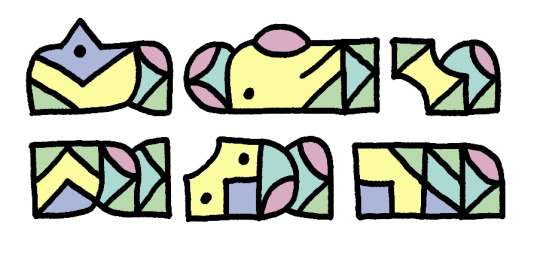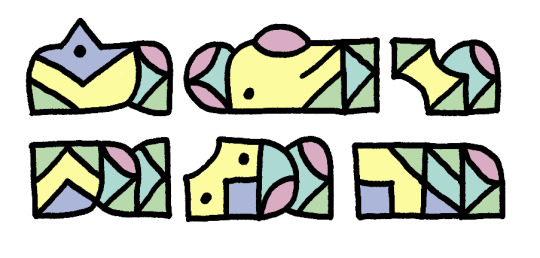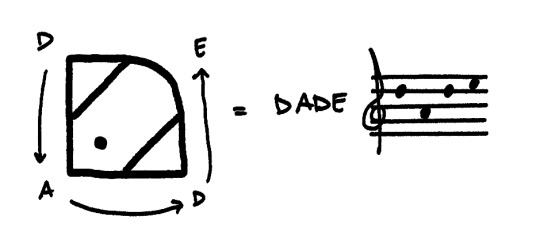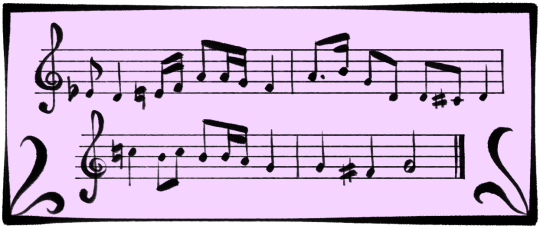#Sdefa
Explore tagged Tumblr posts
Text
Sdefa Sdaturday #21
My first youtube video is now live!
youtube
This is a video all about my musical conlang Sdefa! You’ll hear some music, learn the basics of how the language works, and go through a few examples in detail!
I couldn’t get into too much detail in a short(ish) video, so I didn’t cover Sdefa writing, but I plan to in a future video. The main example in the video is what I showed in last week’s post, but here it is again in both writing systems:


That means “You’re hearing Sdefa, a musical language that I made.” Now you get to actually hear it!
186 notes
·
View notes
Video
youtube
This beat is a modern west coast style instrumental. The bounce and west coast feel is provided by substituting the main snare with a crisp clap sound. The clap really set the west coast vibe in motion and gave that DJ Mustard vibe. I also added a gliding lead melody to give the beat more of a west coast vibe. This beat makes me thing of an artist like YG.vI can definitely here YG and Drake on a beat like this repping da Bay Area. The drums and bass in this beat hit like trap and the melodies hold that west coast feel. I’ll post links to my website below if you want to purchase the beat. Enjoy!
Subscribe: https://goo.gl/KhTZPX. (If it’s not too much trouble, lol) Buy This Beat (Instant Delivery) https://goo.gl/u3aoeH Download This Beat (Non-Profit Use) http://www.lefbeatz.com/ Buy 3 Beats Get 2 Free | http://www.lefbeatz.com/ Contact: [email protected]
West Coast Bay Area Trap Beat "For Da Bay" | Bay Area YG Type Trap Beat 2018
● Twitter: https://Twitter.com/cpistol86 ● Facebook: https://Facebook.com/lefproducer ● Instagram: https://goo.gl/sdEFAe ● SoundCloud: https://SoundCloud.com/lefbeatz
#type beat#free west coast type beat#bay area west coast#bay area#west coast#trap beat#west coast type beat#Bay Area type beat#yg#yg type beat#free beat#free beats#yg bay trap beat#beats#instrumental#free instrumentals#beats for sale#buy beats#beats for rappers#beats for singers#beats for free#west coast instrumentals#yg the rapper
0 notes
Text
Sdefa Sdaturday #19
A very short translation today! I was really amused by one line from the recent LHAB conlang relay: specifically, “I keep making myself beautiful, and I like that.” So here it is in Sdefa:
Weirdly enough, I already had everything in Sdefa I needed to translate “I keep making myself beautiful,” but I had no verb for “like.” It’s weird how conlangs develop sometimes!
This is what it looks like written out:

(I chose to let the computer play the music for me today. It’s definitely more in tune than the piano would be right now, anyway!)
25 notes
·
View notes
Text
Sdefa Sdaturday #20

This is part of a bigger Sdefa project that I’m working on, hopefully to be finished by next weekend! It says, “You’re hearing Sdefa, a musical conlang that I created.” I haven’t recorded it, though, so it’s not actually true … yet!
I realized today that I didn’t actually have much musical terminology in Sdefa. Somehow I didn’t even have a verb “to hear,” though I did have “listen,” {F E F C}. But even that verb is more like “pay attention to,” “heed,” and not always specific to hearing.
I now have more music-related terms! {C B♭ C D} is “hear,” {D A E G F} is “musician,” and {E A D C♯ B} is “melody.” You can say “note” by using the singulative form of “melody,” something like {B A E E A D C♯ B}—basically, “one bit of a melody.” I don’t have a word for “chord” yet but you could also use the singulative of that word for “note” in a slightly different sense.
In this text, “musical” is more specific than it is in English. Literally, it’s “made of melodies.” That’s because the harmonies and even rhythms of Sdefa are incidental—the meaning is just in the sequence of notes. In other contexts, you could also translate “musical” as “having to do with melodies,” or as “made of/having to do with songs,” “… chords,” etc. once I have those words.
Next week I’ll have a recording of this, hopefully with a bit more as well! But for those of you who can read music, this is what it’ll sound like:

17 notes
·
View notes
Text
Sdefa Sdaturday #18
I’m very tired today but I felt like writing something in Sdefa anyways! I didn’t have any big ideas for stuff to write, so here is a translation of “I’m very tired but I want to write in Sdefa, so I’m writing.”
I will come back and add orthography at some point but for now you just get the one word shown on the audio player, which is “tired.”
The audio this time is computer generated because I’m definitely too tired to try recording it myself!
21 notes
·
View notes
Text

Here’s a preview of a new Sdefa translation! It should be ready to post properly by next Saturday.
22 notes
·
View notes
Note
if you don't mind me asking, what are you using to write in sdefa? (for both writing systems)
Not at all! For the older writing system I use Inkscape. I have a document set up with a grid guide and a standard line thickness that I can copy from one line to another. For the newer system, I have a font that I made, so I can use pretty much any program that can handle text for that. I designed the glyphs in Inkscape and made the font itself in FontForge.
Here’s a demo of making the word {B C B E} “cat” with a third-person pronoun suffix in both systems:
For the first sytem, each 4-note root word’s glyph is contained within a 6×6 square, which gives everything convenient proportions to get the types of curves I want without having to do lots of little adjustments. Initially I played around with copying and pasting parts of root words, since there are only 12 different note shapes which fit together, but in the end it was easier to just make each new word from scratch.
For the second system, I just set the font (and fixed the fill and stroke settings) and then typed “7274132,” which corresponds to the notes {B C B E E G A}.* Certain glyphs automatically change when a following letter is typed to form ligatures. This word doesn’t have any sharps or flats but if it did they’d be typed with a + or - respectively after the adjusted note.
107 notes
·
View notes
Text
Sdefa Sdaturday #15
If you weren’t able to join us for the livestream of the Conlang Conflict finale, you can watch the video here! Sadly, Team Let’s Have a Bouba didn’t win but I’m pretty sure we still have the most cumulative points across our three games so that should count for something :P
I decided at the last minute to make two short Sdefa fragments for the occasion! This one is a rough translation of “Conlang Conflict”:
It literally reads “A conflict which has to do with conlangs.” I almost made it something like “the conflicts are fighting” instead! Parts of it sound quite a bit like this text from Kopikon, because of the similar subject matter!
And this one says “Team LHAB”:
In this case “LHAB” is borrowed as a proper noun like “hobbit” was in this post, using a prefix that indicates a borrowed word followed by “L” becoming the note E, “H” becoming B (because of German notation), A of course being A, and “B” becoming B♭ (again, because of German notation).
Here is the Zoom background I made for today, featuring the written form of the two Sdefa fragments on either side, along with several other conscripts! Everything on the left reads “Conlang Conflict,” and everything on the right is “Team Let’s Have a Bouba”! At the top is T’owal; the Sdefa text is the colorful blobby shapes, Tlette is below the lower Sdefa glyph on the right, and the rest is two different conscripts for English, one of which (the twisted and knotted ropes) is very new!

33 notes
·
View notes
Text
Sdefa Sdaturday #22
youtube
It’s a new Sdefa video! This is a short (~50-second) response to a message someone sent me after she watched my Introduction to Sdefa. Her message was so sweet and sincere that I thought it deserved a proper answer, by which I mean an answer in Sdefa itself!
7 notes
·
View notes
Text
youtube
I just posted a Sdefa video to my conlanging Youtube page! If you’ve followed me for a while, you may have seen this before, but since it is a video it made sense to share it to Youtube as well.
7 notes
·
View notes
Text
Sdefa Sdaturday #14
Here’s a new Sdefa translation!
If you haven’t seen my previous posts, Sdefa is a constructed language which is played on musical instruments rather than spoken or signed. So this is both a translation of a poem and also a piece of music for solo piano!
There’s a lot of flexibility built into how the language works, so it’s as much a compositional tool as a means of communication—the same text could be conveyed in many different ways, as the rhythms, chords, dynamics, instrument(s), and even some of the melody notes can be changed without changing the meaning.
This a translation of a poem from The Fellowship of the Ring, written by Bilbo and recited at the Council of Elrond. Here’s the original poem:
All that is gold does not glitter, Not all those who wander are lost; The old that is strong does not wither, Deep roots are not reached by the frost.
From the ashes a fire shall be woken, A light from the shadows shall spring; Renewed shall be blade that was broken, The crownless again shall be king.
There are a number of new words in this translation. Like other Sdefa words, they’re all 4- or 5-note references to other pieces of music. One of the new words here is D A D E, “shadow” or “darkness,” which is based on a fragment of the song that Pippin sings in The Return of the King movie! There’s another LotR reference in the language, though not used in this piece: F A G E♭, meaning “horse,” comes from Shadowfax’s theme in The Two Towers. That was actually one of the first words I made for the language!
42 notes
·
View notes
Text
Sdefa Sdaturday #17
Since I recently updated the Sdefa orthography, I’d like to show how it works!
Root words are four- or five-note sequences, and are written as little square-ish shapes. Each of the twelve possible pitch classes has a different style of corner, and you combine four corners to make a whole shape.

You start from the top left and go counterclockwise to spell out the root word:

Five-note words are stretched horizontally to fit the last note in at the top (in a slightly different form reserved for that position).

So far that’s all the same as it was before. The difference is in the affixes, which previously had dedicated symbols for each meaning, rather than showing the note content (kind of like using an ampersand instead of writing out “and”). Now they show the note content, but (since affixes work differently in the language than roots), they’re still notated in their own way.
Affix glyphs/ligatures have two parts, and attach to the side of a root word. They’re defined based on intervals rather than pitch classes, so they borrow six of the natural notes to indicate intervals, based on their distance from C, so e.g. you use D to indicate a step up.

The last note of the root is the first note of the suffix, followed by two more notes. The top part of the suffix symbol is the next interval from that note, then the bottom note shows the interval from the previous note, so the writing order is a little boustrophedon-ish.

You can add more suffixes on the right, or prefixes on the left. To figure out the notes of a prefix you have to look at the intervals from the beginning of the root, going backwards; also, the first interval of a prefix is on the bottom and the second on the top, flipped from how suffixes are written. Affixes are always written in the same direction so they always have the same form. So if have a word with one prefix and one suffix, you’ll write in a sort of ↗ ↘↗ ↘ pattern, but if there are more affixes it’ll be like ↗↗ ↘↗ ↘ ↘.
15 notes
·
View notes
Text
Sdefa Sdaturday #3

This is a new short piece of music, which is also a text in my musical conlang Sdefa! It translates to:
Snow is falling outside the house. But inside the house is warm And a cat is sleeping peacefully.
Below is a simplified version of the text with a basic gloss. Rhythms and chords are omitted because they’re not part of the text itself. Full barlines divide words, and half barlines divide suffixes from their roots or other suffixes on the same word. In the gloss, the numbers refer to the three free suffixes used in the text. That’s explained a bit in this post, but the basic idea is that each noun is identified with a three-note pronomial suffix which is then used for subject or object agreement on a verb. The numbers aren’t grammatical person —they’re all third person in this case—but are just the order in which they are first used.

There are a few different things I might have done with this text. For one, there’s no tense or aspect marking, since it isn’t required. Second, there’s actually no equivalent of “but” in the Sdefa text; instead, that section of the music has a couple of chord changes that bring a change in mood. I actually don’t have a way to say “but” in Sdefa yet, and I may leave it out of the language entirely.
I hope you enjoyed the music! Sdefa is a lot of fun to use and it’s an enjoyable challenge to make musical sense out of it. This post is coming a little later than usual both because it took quite a while to put this all together and because the recording was delayed due to a certain kitty cat being on my lap.
55 notes
·
View notes
Text
Sdefa Sdaturday #1

Sdefa is my newest conlang, started in July of last year. Like T’owal, it isn’t intended to be naturalistic, but it takes that lack of naturalism a lot farther! Instead of being a spoken language, it’s a musical one; its twelve phonemes are the twelve notes of the Western chromatic scale. It’s playable on any chromatic instrument, since you never need to play more than one note at a time. That means you can sing it, too!
If you do sing it, then of course the syllables you sing don’t matter—just the pitches. The word “Sdefa” doesn’t actually mean anything in the language; instead, it’s a sort of transliteration of the language’s “actual” name, which is the sequence of notes E♭ D E F A. In German music terminology, the note E♭ is called “Es,” so here that translates to the letter S. The Germans also call B♭ “B” and B “H,” which is how the great composer J. S. Bach was able to compose using his musical signature, B♭ A C B.
Almost every word in Sdefa is a tiny musical reference, four or five notes long. In fact, B♭ A C B is a Sdefa word, meaning “great,” since Bach is one of the greatest composers of all time. Most of the references are fragments of songs, usually bits that have lyrics that match the meaning of the word. Other references are parts of pieces whose titles match the meaning in some way. Some other words are:
⁕ D A F D, meaning “art,” from the beginning of the theme from Bach’s Art of Fugue
⁕ G C E D, meaning “deep,” from the first four notes of the main theme from Star Trek: Deep Space Nine
⁕ E D G F, meaning “moon,” from the song שײן װי די לבֿנה/Sheyn vi di Levuna (“Pretty as the Moon”)
The word “Sdefa” itself isn’t a reference, though; it’s just something that sounded nice both as a sequence of notes and as a spoken word.
It’s not just the syllables that don’t matter if you’re singing Sdefa. Rhythm and register are not part of the language, so D A F D would mean “art” regardless of the note values or octave(s) it’s played in. This allows the language to be flexible, giving a Sdefa text better chance of having a musical quality instead of sounding like a string of random notes. However, since there are so few phonemes and everything can be played in multiple ways, it does mean that most things take a surprising number of notes to say, and that can take a long time unless you use a fast tempo!
Next week I’ll get a bit into the grammar of Sdefa, and explain how the music at the top of the post translates (loosely) into “Sdefa Saturday!”
60 notes
·
View notes
Text
Sdefa Sdaturday #10
Later today, at 4:00 EDT (about three and a half hours from time of posting), please join me and my friends for our conlang relay presentation! We actually already gathered to discuss the relay but today the video of that discussion is going up on Youtube as a premiere, so you can join us in chat!
I’m not going to post details of my contribution to the relay yet, for spoiler reasons, but here’s the text in the first Sdefa script, which is what the person after me in the relay had to translate:

(A draft of this text was posted a few weeks ago, but there are some differences.)
And here is the same text in the newer Sdefa script:

I hope you can join us today!
41 notes
·
View notes
Text
Sdefa Sdaturday #7
For the last week or so I’ve spent all of my free time working on a translation into Sdefa. It’s for a conlang relay that some friends and I are doing, so I can’t reveal anything about the meaning of the text until after that’s complete, but I think I can get away with posting a nearly-final draft of the text itself without context. It’s the longest Sdefa text so far, by quite a bit!

I had to come up with nineteen new words and a few new bits of grammar for this translation. I’m hoping to record it as a duet for viola and cello, and I’m guessing that it’ll end up being at least six minutes long!
38 notes
·
View notes